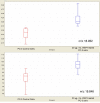Effect of Turkish propolis extracts on proteome of prostate cancer cell line
- PMID: 22152088
- PMCID: PMC3286392
- DOI: 10.1186/1477-5956-9-74
Effect of Turkish propolis extracts on proteome of prostate cancer cell line
Abstract
Background: Propolis is a natural, resinous hive product that has several pharmacological activities. Its composition varies depending on the vegetation, climate, season and environmental conditions of the area from where it was collected. Surface enhanced laser desorption ionization time of flight mass spectrometry (SELDI-TOF MS) is a proteomic approach which has been used in cancer proteomics studies. Prostate cancer is one of the most commonly diagnosed cancers in men. It has shown that nutritional supplements rich in polyphenolic compounds such as propolis play a significant role in prostate cancer chemoprevention. The aim of this study is to evaluate if protein expression profile in PC-3 prostate cancer cell lines could be differentiated when incubated with dimethyl sulfoxide and water extracts of Turkish propolis.
Results: The antioxidant potentials of dimethyl sulfoxide and water extracts of propolis were found in correlation with the amount of total phenolic compounds of them. Dimethyl sulfoxide and water extracts of propolis of 20 μg/mL reduced the cell viability to 24.5% and 17.7%, respectively. Statistically significant discriminatory peaks between control PC-3 cells and dimethyl sulfoxide extract of propolis-treated PC-3 cells were found to be the proteomic features at m/z 5143, 8703, 12661, 20184 and 32794, detected by CM10 ProteinChip, and the peak at m/z 3772, detected by Q10 ProteinChip. Between control PC-3 cells and water extract of propolis-treated PC-3 cells, statistically significant discriminatory peaks were found to be the proteomic features at m/z 15846, 16052 and 24658, detected by CM10 ProteinChip and the peaks at m/z 10348, 10899 and 11603, detected by Q10 ProteinChip.
Conclusions: It was concluded that dimethyl sulfoxide and water extracts of Turkish propolis may have anti-proliferative activity through differentiating protein expression profile in PC-3 prostate cancer cell lines along with their antioxidant capacity.
Figures






Similar articles
-
Protein profiling of post-prostatic massage urine specimens by surface-enhanced laser desorption/ionization time-of-flight mass spectrometry to discriminate between prostate cancer and benign lesions.Oncol Rep. 2009 Jan;21(1):73-9. Oncol Rep. 2009. PMID: 19082445
-
Antitumoral and Antioxidant Potential of Egyptian Propolis Against the PC3 Prostate Cancer Cell Line.Asian Pac J Cancer Prev. 2015;16(17):7641-51. doi: 10.7314/apjcp.2015.16.17.7641. Asian Pac J Cancer Prev. 2015. PMID: 26625775
-
Discovery of diagnostic biomarkers for pancreatic cancer in immunodepleted serum by SELDI-TOF MS.Pancreatology. 2012 Mar-Apr;12(2):124-9. doi: 10.1016/j.pan.2012.02.009. Epub 2012 Feb 21. Pancreatology. 2012. PMID: 22487522
-
Surface-enhanced laser desorption ionization time-of-flight mass spectrometry (SELDI TOF-MS) and ProteinChip technology in proteomics research.Pathol Res Pract. 2004;200(2):83-94. doi: 10.1016/j.prp.2004.01.010. Pathol Res Pract. 2004. PMID: 15237917 Review.
-
Chemopreventive and Chemotherapeutic Effect of Propolis and Its Constituents: A Mini-review.J Cancer Prev. 2020 Jun 30;25(2):70-78. doi: 10.15430/JCP.2020.25.2.70. J Cancer Prev. 2020. PMID: 32647648 Free PMC article. Review.
Cited by
-
Effects of copaene, a tricyclic sesquiterpene, on human lymphocytes cells in vitro.Cytotechnology. 2014 Aug;66(4):597-603. doi: 10.1007/s10616-013-9611-1. Epub 2013 Nov 28. Cytotechnology. 2014. PMID: 24287609 Free PMC article.
-
Polyphenol profile by UHPLC-MS/MS, anti-glycation, antioxidant and cytotoxic activities of several samples of propolis from the northeastern semi-arid region of Brazil.Pharm Biol. 2017 Dec;55(1):1884-1893. doi: 10.1080/13880209.2017.1340962. Pharm Biol. 2017. PMID: 28631525 Free PMC article.
-
Determination of antioxidant activity and phenolic compounds for basic standardization of Turkish propolis.Appl Biol Chem. 2021;64(1):37. doi: 10.1186/s13765-021-00608-3. Epub 2021 Apr 16. Appl Biol Chem. 2021. PMID: 33880424 Free PMC article.
-
An Insight on the Biomedical Potential of Portuguese Propolis from Gerês.Foods. 2022 Oct 29;11(21):3431. doi: 10.3390/foods11213431. Foods. 2022. PMID: 36360044 Free PMC article.
-
Does propolis have any effect on rheumatoid arthritis? A review study.Food Sci Nutr. 2022 Mar 10;10(4):1003-1020. doi: 10.1002/fsn3.2684. eCollection 2022 Apr. Food Sci Nutr. 2022. PMID: 35432965 Free PMC article. Review.
References
-
- Vıuda-Martos M, Ruız-Navajas Y, Fern'andez-L'opez J, P'erez-'Alvarez JA. Functional properties of honey, propolis and royal jelly. J Food Sci. 2008;73(9):116–124. - PubMed
LinkOut - more resources
Full Text Sources

